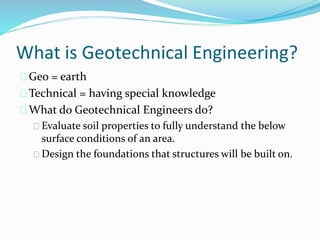The Best Guide To Geotheta
The Best Guide To Geotheta
Blog Article
The Buzz on Geotheta
Table of ContentsMore About GeothetaHow Geotheta can Save You Time, Stress, and Money.5 Easy Facts About Geotheta ShownGeotheta - QuestionsThe Ultimate Guide To Geotheta

They conduct site examinations, accumulate samples, perform laboratory tests, and examine information to examine the viability of the ground for construction projects - Geo Tech Engineering. Based on their findings, geotechnical designers give recommendations for foundation style, incline security, maintaining frameworks, and reduction of geotechnical threats. They team up with various other professionals, such as engineers, architectural engineers, and construction teams, to ensure that geotechnical factors to consider are incorporated right into the total project design and application
By analyzing the actions and homes of soil and rock, they can identify potential geotechnical threats such as landslides, dirt negotiation, or incline instability. Their knowledge aids prevent failures or mishaps that might endanger lives and building. Right here are some comprehensive duties and responsibilities of a geotechnical designer: Site Investigation: Geotechnical designers conduct site examinations to collect information on subsurface problems.
They analyze the information to understand the residential properties and actions of the dirt and rock, including their toughness, leaks in the structure, compaction features, and groundwater problems. Geotechnical Evaluation and Style: Geotechnical designers examine the information accumulated during website investigations to evaluate the stability and suitability of the website for construction jobs. They carry out geotechnical computations and modeling to examine variables such as birthing capacity, settlement, incline security, side earth pressures, and groundwater flow.
Getting My Geotheta To Work
Foundation Layout: Geotechnical designers play a critical function in developing foundations that can securely sustain the desired structure. They evaluate the soil conditions and lots demands to determine the proper foundation kind, such as shallow foundations (e.g., grounds), deep foundations (e.g (https://forums.hostsearch.com/member.php?265240-geotheta)., heaps), or specialized strategies like dirt enhancement. They take into consideration elements such as negotiation restrictions, bearing capacity, and soil-structure interaction to develop optimal foundation styles
They review building and construction strategies, screen website tasks, and carry out field evaluations to verify that the layout suggestions are complied with. If unpredicted geotechnical problems emerge, they analyze the circumstance and offer referrals for remediation or adjustments to the style. Threat Analysis and Reduction: Geotechnical engineers assess geotechnical dangers and risks associated with the job site, such as landslides, liquefaction, or dirt disintegration.

Partnership and Communication: Geotechnical designers function closely with various other experts involved in a project, such as designers, architectural designers, and building teams. Effective interaction and collaboration are necessary to integrate geotechnical factors to consider into the overall task style and building and construction process. Geotechnical designers offer technological know-how, response inquiries, and ensure that geotechnical needs are met.
Get This Report on Geotheta
Here are some types of geotechnical engineers: Foundation Designer: Structure engineers focus on developing and assessing structures for structures. They evaluate the dirt conditions, tons needs, and website qualities to figure out one of the most appropriate foundation type and design, such as shallow foundations, deep foundations, or specialized techniques like stack structures.
They examine the aspects affecting slope security, such as soil homes, groundwater conditions, and slope geometry, and establish methods to avoid incline failures and mitigate risks. Quake Engineer: Earthquake designers specialize in assessing and making frameworks to stand up to seismic forces. They examine the seismic threat of a website, review dirt liquefaction possibility, and develop seismic design requirements to guarantee the security and resilience of structures throughout earthquakes.
They carry out field screening, gather samples, and analyze the accumulated information to define the soil buildings, geologic developments, and groundwater conditions at a site. Geotechnical Instrumentation Engineer: Geotechnical instrumentation designers concentrate on monitoring and determining the habits of dirt, rock, and structures. They mount and keep instrumentation systems that monitor factors such as dirt negotiation, groundwater levels, incline activities, and structural variations to evaluate efficiency and provide very early warnings of possible concerns.
6 Easy Facts About Geotheta Described
They carry out examinations such as triaxial examinations, combination tests, direct shear tests, and leaks in the structure examinations to collect information for geotechnical analysis and design. Geosynthetics Engineer: Geosynthetics designers concentrate on the layout and application of geosynthetic products, such as geotextiles, geogrids, and geomembranes. They make use of these products to boost dirt stability, reinforce slopes, give drain remedies, and control disintegration.
They tend to be investigatory people, which implies they're intellectual, introspective, and curious. They are interested, systematic, sensible, logical, and rational. Some of them are also social, suggesting they're kind, generous, participating, individual, caring, handy, understanding, sensible, and friendly - Engineer of Record.
In the workplace environment, geotechnical engineers make use of specialized software application tools to carry out estimations, create designs, and examine information. They prepare records, review project specifications, interact with clients and group participants, and coordinate project activities. The workplace setting provides a favorable environment for research study, analysis, and collaboration with various other specialists included in the job.
The Basic Principles Of Geotheta
They regularly see project websites to conduct website examinations, examine geotechnical conditions, and collect information for evaluation. These check outs involve traveling to different places, often site web in remote or challenging terrains. Geotechnical designers might do soil sampling, conduct tests, and display construction tasks to guarantee that the geotechnical aspects of the project are being executed properly.
Geotechnical designers likewise function in specialized geotechnical research laboratories. Geotechnical research laboratory designers function thoroughly in these settings, handling testing tools, operating instruments, and videotaping data.
Report this page